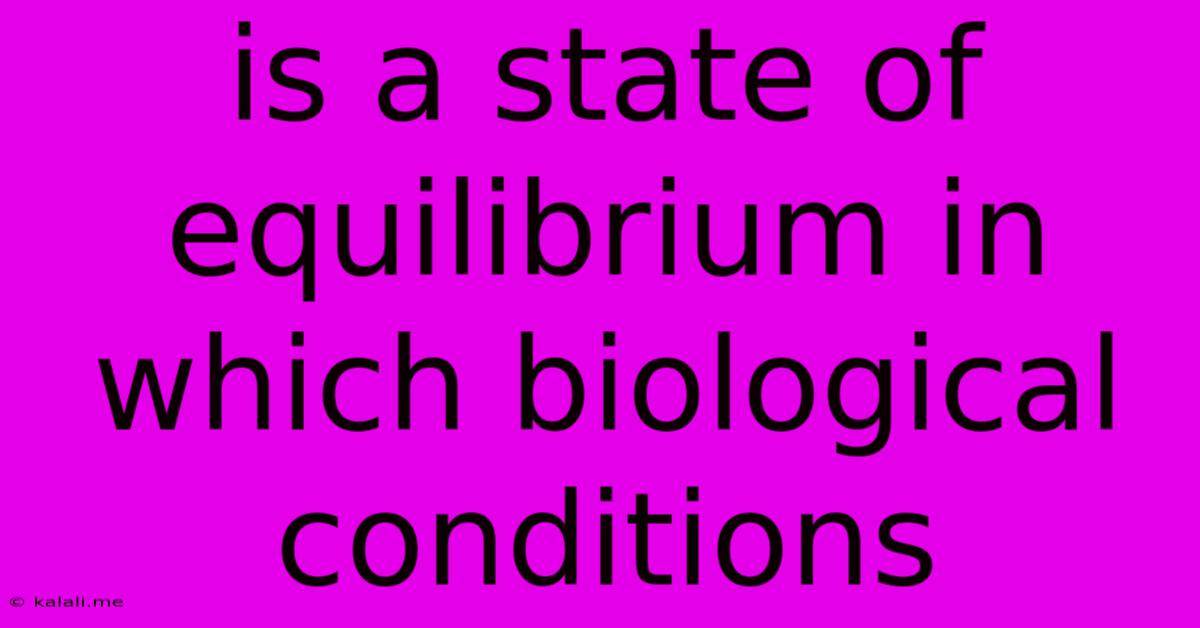Is A State Of Equilibrium In Which Biological Conditions
Kalali
May 10, 2025 · 3 min read

Table of Contents
Homeostasis: The Body's Internal Balance
Maintaining a stable internal environment is crucial for survival. This delicate balance, essential for proper cellular function and overall health, is known as homeostasis. This article will delve into the intricacies of homeostasis, exploring its mechanisms, importance, and the consequences of its disruption.
Homeostasis is a dynamic process, constantly adjusting to internal and external changes. Think of it as a sophisticated thermostat, constantly monitoring and regulating various physiological parameters to keep them within a narrow, optimal range. This includes maintaining stable body temperature, blood pressure, blood glucose levels, and fluid balance. Understanding homeostasis is fundamental to comprehending how the human body functions and the underlying causes of many diseases.
Mechanisms of Homeostasis: A Delicate Dance of Feedback Loops
The body employs intricate feedback mechanisms to maintain homeostasis. These mechanisms primarily involve two types of loops:
-
Negative Feedback Loops: These are the most common type of homeostatic control. They work by counteracting any deviation from the set point. For example, when body temperature rises above the set point (around 98.6°F or 37°C), the body initiates mechanisms to cool down, such as sweating and vasodilation. Conversely, when the temperature drops below the set point, shivering and vasoconstriction occur to generate heat. This process ensures the body temperature returns to the optimal range.
-
Positive Feedback Loops: These loops amplify the initial stimulus, moving the system further away from the set point. While seemingly counterintuitive to homeostasis, positive feedback loops are crucial in specific processes, such as blood clotting and childbirth. In blood clotting, the initial activation of platelets triggers a cascade of events that accelerates the clotting process, ultimately stopping the bleeding. Similarly, during childbirth, uterine contractions trigger the release of oxytocin, which further stimulates contractions until the baby is delivered. These loops are typically self-limiting and only operate for short periods.
The Importance of Homeostasis: A Foundation for Health
Maintaining homeostasis is essential for numerous reasons:
-
Cellular Function: Cells require a stable environment to function optimally. Fluctuations in parameters like pH, temperature, and ion concentrations can disrupt enzyme activity and cellular processes, leading to cell damage or death.
-
Organ System Function: Proper functioning of organ systems relies on a stable internal environment. For example, the kidneys maintain fluid and electrolyte balance, while the respiratory system regulates blood pH and oxygen levels.
-
Overall Health: Disruptions in homeostasis can lead to a wide range of health problems, from mild discomfort to life-threatening conditions. Maintaining a stable internal environment is fundamental for preventing disease and promoting overall well-being.
Homeostatic Imbalance: When the System Fails
When the body's homeostatic mechanisms fail to adequately respond to internal or external challenges, a state of homeostatic imbalance occurs. This can be caused by various factors, including:
-
Disease: Many diseases involve disruptions in homeostasis. Diabetes, for example, is characterized by an imbalance in blood glucose levels. Hypertension (high blood pressure) represents a disruption in cardiovascular homeostasis.
-
Injury: Trauma and injury can disrupt homeostasis by causing fluid loss, electrolyte imbalances, and other physiological disturbances.
-
Environmental Factors: Extreme temperatures, lack of oxygen, and exposure to toxins can overwhelm the body's homeostatic mechanisms.
-
Aging: The efficiency of homeostatic mechanisms often declines with age, increasing vulnerability to imbalances.
Conclusion: The Dynamic Equilibrium of Life
Homeostasis is a dynamic and complex process that is fundamental to life. Understanding its mechanisms and the consequences of its disruption is critical for maintaining health and preventing disease. By appreciating the intricate balance that our bodies maintain, we can better understand the importance of healthy lifestyle choices and the need for prompt medical attention when homeostatic imbalances occur. Maintaining a healthy lifestyle, including proper nutrition, regular exercise, and stress management, supports the body's ability to maintain this essential equilibrium.
Latest Posts
Latest Posts
-
What Fraction Is Equivalent To 1 2
Jul 13, 2025
-
What Is The Average Iq For A 9 Year Old
Jul 13, 2025
-
How Long Does It Take For Brandy Melville To Ship
Jul 13, 2025
-
How Many Times Does 3 Go Into 30
Jul 13, 2025
-
In What Episode Of Bleach Does Ichigo Ask Orihime Out
Jul 13, 2025
Related Post
Thank you for visiting our website which covers about Is A State Of Equilibrium In Which Biological Conditions . We hope the information provided has been useful to you. Feel free to contact us if you have any questions or need further assistance. See you next time and don't miss to bookmark.